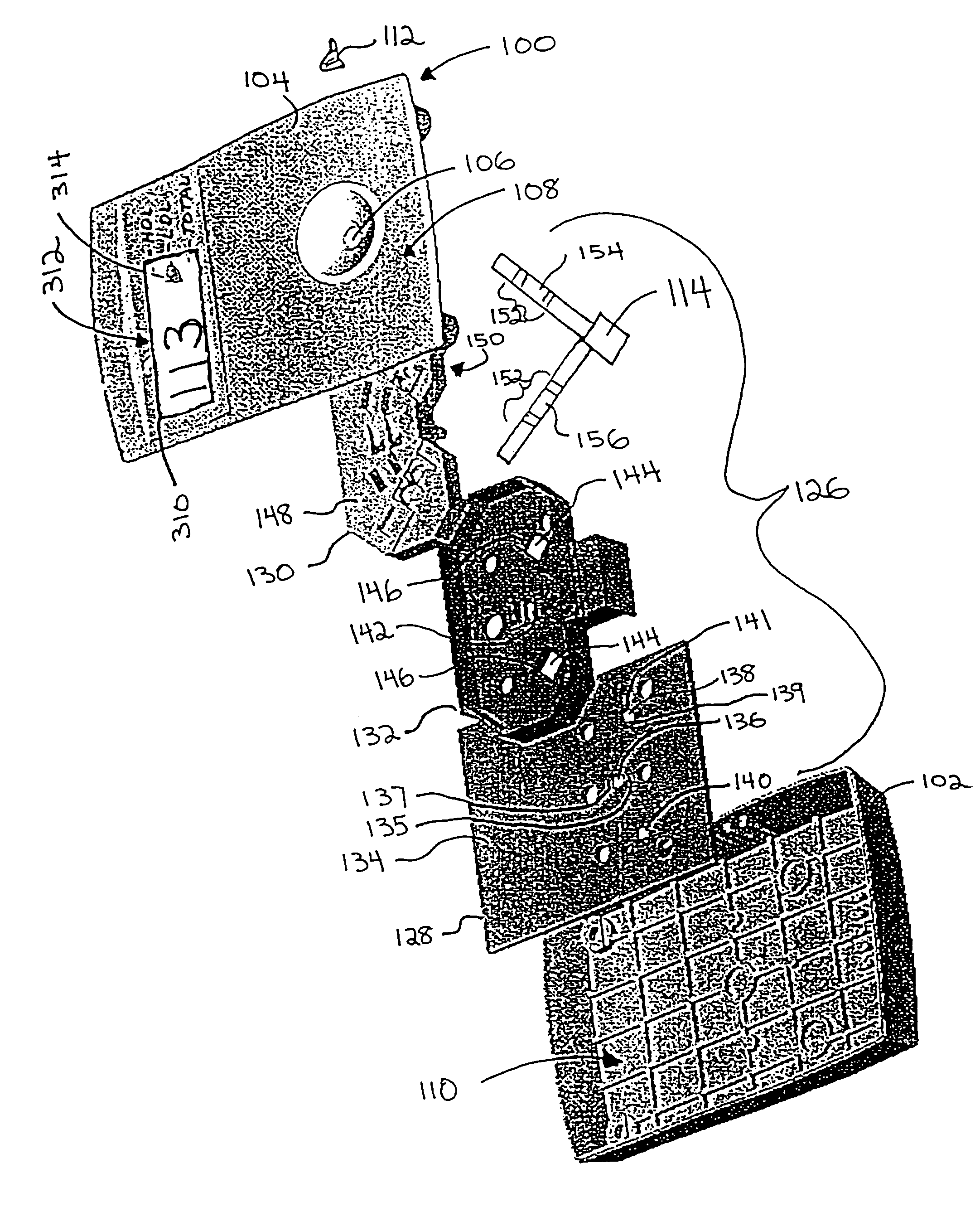Dry reagent strip configuration and systems and methods for multiple analyte determination
a technology of multiple analyte and strip configuration, which is applied in the direction of biomass after-treatment, analysis using chemical indicators, instruments, etc., can solve the problems of inability to achieve quantitative results necessary for cholesterol testing, methods generally undesirable for point-of-care testing, and inability to achieve uniform and sharp colors on these devices, etc., to achieve accurate quantitative results
- Summary
- Abstract
- Description
- Claims
- Application Information
AI Technical Summary
Benefits of technology
Problems solved by technology
Method used
Image
Examples
example 1
[0065]Preparation of general chemistry strips for the detection of creatine and creatinine according to the present invention used three separate processes. The first process is to impregnate a roll of nylon membrane in a suspension of 15% Titanium Dioxide. This suspension is prepared by mixing in a high-speed mixer the follow components in successive order: 0.25g / mL 1% PVA 186K; 0.5966 g / mL distill Water; 0.00075 g / mL Tripolyphospate; 0.00075 g / mL Fumed Silicon Dioxide; and 0.15 g / mL Titanium Dioxide. After coating, the membrane is dried at 37° C. for 10 minutes and allowed to equilibrate to room condition for at least 8hours prior to the second coating.
[0066]The second process is to stripe two separate enzyme solutions simultaneously using a platform striper with a metered pump such as those made by IVEK of North Springfield, Vt. Other applicators suitable for use with the present invention include, but are riot limited to, a fountain pen, a pad printer, pipette, air brush, metere...
example 2
[0076]In this example, the effectiveness of the creatinine strip of the present invention to correct for creatine in a sample is demonstrated. Urine samples were spiked with known amount of creatine and creatinine. The range for each did not exceed 15 mM for either analyte. A modified reference assay from Boehringer Mannhiem Corp. was used to find the reference value for both creatine and creatinine in these samples. Creatinine strips were run according to Example 1. Calibration curves for both test zone 1 and test zone 2 were performed according to Example 1. The measurement of test zone 1 represents the amount of creatine in a sample and the measurement of test zone 2 represents the sum of creatine and creatinine in a sample. To correct of creatine, the value of test zone 1 is subtracted from the value of test zone 2. The results from these samples are summarized in Table 2. FIG. 8 presents a graph showing the correlation between the reference assay and the strip assay with and wi...
example 3
[0078]In this example, performance of an assay strip of the present invention with and without a hydrophobic barrier between Zone 1 and Zone 2 is compared. Creatinine enzyme membranes were prepared according to Example 1. In one set of chemistry reagent membranes, a 0.5 mm wide hydrophobic solution was striped. A second set of chemistry reagent membranes was prepared without a hydrophobic barrier. A sample spiked with 10 mM creatine and 20 mM creatinine was used according to Example 1. Kinetic profiles of the reflectance ratio (R / Ro) over time are illustrated in FIGS. 9 and 10 for assay strips without and with the hydrophobic zone, respectively. The profiles illustrated in FIGS. 9 and 10 showed little difference observed by adding the hydrophobic zone. If a rapid increase in R / Ro in test zone 1 had been observed after the strips began developing, diffusion of the sample from test zone 1 into test zone 2 would have been indicated. Based on these profiles, no detectable diffusion of t...
PUM
| Property | Measurement | Unit |
|---|---|---|
| pore size | aaaaa | aaaaa |
| thickness | aaaaa | aaaaa |
| thickness | aaaaa | aaaaa |
Abstract
Description
Claims
Application Information
 Login to View More
Login to View More - R&D
- Intellectual Property
- Life Sciences
- Materials
- Tech Scout
- Unparalleled Data Quality
- Higher Quality Content
- 60% Fewer Hallucinations
Browse by: Latest US Patents, China's latest patents, Technical Efficacy Thesaurus, Application Domain, Technology Topic, Popular Technical Reports.
© 2025 PatSnap. All rights reserved.Legal|Privacy policy|Modern Slavery Act Transparency Statement|Sitemap|About US| Contact US: help@patsnap.com



